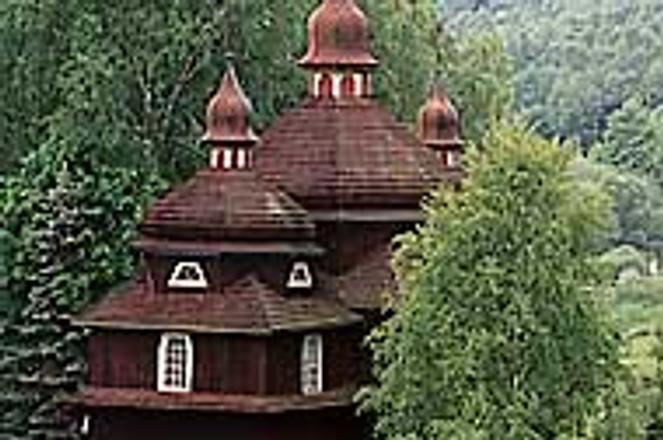THIS TRADITIONAL wooden church in Nižný Komárnik, along with most others, still holds services for the faithful.photo: Ján Svrček
IT IS Sunday morning in late July, and the citizens of the smallest Slovak village, Príkra (pop. 10), are gathering for mass. At the ringing of the bells they climb a gentle hill to a grove of massive lime trees that hide a tiny wooden church.
Most of the worshippers are their 80s, and lower themselves carefully into their seats in one of the church's six pews. The priest arrives, and conducts the service from a pulpit so close to his flock that those in the front pew could touch his robes, were they to reach out.
"It has its magic. The priest is so close to the people and the space is so small that it creates a very personal, home-like atmosphere," says Eva Semanová from the Regional Conservation Office in Prešov.
The church of St Michael Archangel in Príkra was built in 1777, but still serves the locals. The tiny building is one of 36 traditional wooden churches still standing in the Prešov region, an area of land stretching from central Slovakia to the north and east borders with Poland and Ukraine.
The wooden churches are found mainly in the Svidník and Bardejov districts inhabited by Rusyns, a minority with Ukraine roots. In 1968, 27 of the most valuable churches were proclaimed as part of the nation's cultural heritage. All but one of the churches still conduct regular worship.
"The wooden churches are undoubtedly the most precious form of traditional folk architecture in the country's north-east region," states an annual report produced by Slovak conservationists.
WOODEN church of St. Michal the Archangel, built in 1752.photo: Ján Svrček
Paradoxically, the best-preserved of the churches, built largely during the 17th and 18th centuries, lie in Prešov region's poorest areas. In wealthier communities the churches were often pulled down and replaced by modern facilities.
The wooden church phenomenon, in which the buildings contain not a single nail, spread across the entire Carpathian basin, from Poland, Slovakia and Ukraine to Hungary and Romania. They were erected in almost every village (some of them only a few kilometres apart) from natural materials such as wood and stone. Crosses, handles and gates were produced by local blacksmiths.
However, because of the variety of cultures in the Carpathian region, the churches differ in design not only from country to country but often from one village to another.
"Although they have the same general shape, each one of Slovakia's 36 churches is unique," says Semanová, browsing a catalogue of churches and comparing different architectural elements in their windows and towers and exterior decorations.
"All are built from wood found in the church's neighbourhood. But the church in Prešov district's Brežany, for instance, is the only one that has white paint at the points where the beams connect."
Most of the churches serve the Greek Catholic faith, while a few are Orthodox and Roman Catholic. One Roman Catholic example is the gothic St. Francis of Assisi Church in Hervartov, the oldest wooden church in Slovakia. It was built around 1500 out of wood from the rare yew tree.
ST. MIKULÁŠ church dominates the Prešov city centre.photo: Zuzana Habšudová
A characteristic feature of wooden church architecture is the three-part building, symbolising the Holy Trinity. From the outside, one sees a trio of towers gradually rising towards the west.
The churches also tended to be isolated from other buildings in their communities, on the one hand to stress the sanctity of the building, on the other for protection in case of fire in the village. The structures also typically occupy a dominant position in the village, often sitting on a low hill surrounded by trees.
Free-standing belfries are also common. Once situated inside the churches, the bells had to be removed because they shook the structures at each stroke.
"Even though the churches themselves are usually tiny constructions, the size of the trees that surround them help people realise even from a distance that something special lies within," says Semanová.
"However, we have to take of these trees. If any were to fall on any of these preserved monuments, we would end up with a wood shed instead of a church."


